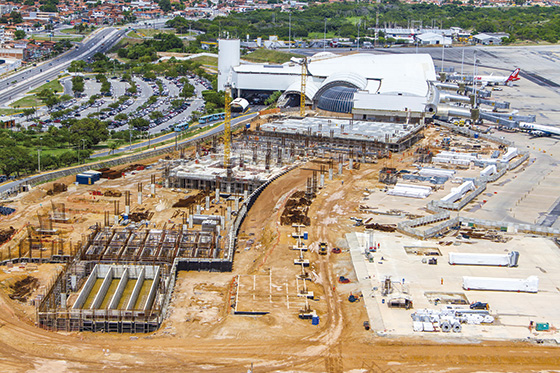Paths for the future

Multi-year Plan points the route for government investments and for activities after fiscal adjustment and end of the crisis. It also keeps urban infrastructure at the top of its priorities
Where Brazil is going to is certainly the question that more concerns all Brazilians. The shuffled scenario makes difficult to preview anything. It is necessary to move away from the present and immediate moment—that already has forecasts well-known by everybody—to look to the perspectives for the next two or three years. Grandes Construções magazine sought for signals that would help it to point these paths for the future. These survey was supported by data and researches carried out by the Federal Government, the National Bank of Economic and Social Development (BNDES) and industry entities such as the National Confederation of Industries, as well as opinions of industry leaders.
One of the main tools that may be used to understand the country is contained in a paper called Plano Plurianual (Multi-year Plan - PPA), developed by the Ministry of Planning. Undoubtedly it is necessary to consider advancements in economic and social indicators during the last ten years.
2015 – Year of adjustments
The PPA 2016–2019 shows a clear change of route, reflecting the new more restrictive internal and external context of the economy. The PPA, produced by the Ministry of Finance that is now leaded by Nelson Barbosa, brings new questions to be discussed. According to this document, the global and national economic growth was decelerated and the decrease in the prices of commodities limited the economy’s potential of growth.
With the reduction of income and the increase of expenses, the consolidated primary result of the public area in 2014 changed its signal, showing a deficit of 0.9 percent of the GDP. At the end of 2014, the government started a gradual program of fiscal balancing and in 2015 a new target of indicative primary result for 2016 was sent again to the Congress. In practice, 2015 was marked by economic recession. The government spent most of its time trying to approve measures that effectively could make feasible the fiscal adjustment proposed by Joaquim Levy, Minister of Finance, what is still going on. Based on this target, we may conclude that the improvement of the primary result along the time to reach 2.0 percent of the GDP for the non-financial public area will occur only in 2018 and 2019 (with 1.65 percent of the GDP due to Federal Government efforts).
Routes for the future
The PPA 2016-2019 estimates—considering the success of the government adjustment—a recovering of Brazilian economy only from 2016 on, with reduction of the inflation. The increase of the commercial balance (net external demand) will mark the start of economy’s recovering, complemented by a new cycle of investments that will come through the increase and redesign of several government programs (such as PAC, PNE, PIL, PIEE and PNBL). The government foresees that the decrease of inflation will allow the reduction of interest rates and the reconstitution of the purchasing power of wages, with positive effects on family income and expectations. The recovery of investments and consumption will be followed by the expansion of credit.
The government is signalizing with three central guidelines for this recovery: first, the economic recovery itself; second, the bet in education and workers—what includes infrastructure—to continue to grow; and third, public government management.
In this sense, the document of the government points to a commitment with: the improvement of education quality; investments that are going on in the Plano de Aceleração do Crescimento 2 (Plan of Growth Acceleration 2 - PAC 2) and in the Programa Minha Casa Minha Vida ( Program My House My Life - MCMV); the increase of the program of concessions in 2015, starting the new phase of the Programa de Investimentos em Logística (Program of Investments in Logistics - PIL), that foresees R$ 69.2 billion of investments in roads, railways, airports and ports between 2015 and 2018 and more R$ 129.2 billion from 2019 on. It also includes a program to reduce bureaucracy and to simplify the deals which are going on and to increase policies of encouragement to innovation and access to new markets.
Considering the internal scenario of stability and priority to the increase of productivity and an uncertain external scenario with soft adjustment of external accounts, the government estimates that the economy will start to recover the growth pace in 2016 maintaining a path of acceleration that will lead it to 2.5 percent of annual increase in the GDP at the end of this period. At the same time, it is foreseen a deceleration of the inflation after the corrections of managed prices and the absorption of exchange and food crashes that marked the period 2014-2015, keeping the inflation in the middle of the target from 2017 on. In these conditions, the basic interest rate will decrease in the period, fitting the gradual recovery of the activities to the deceleration of prices.
Allocation of resources – Infrastructure (total values of programs)
Urban Infrastructure 52%
Oil and Gas 20%
Power 15%
Transports 8%
Fuels 3%
Other 2%

Av. Francisco Matarazzo, 404 Cj. 701/703 Água Branca - CEP 05001-000 São Paulo/SP
Telefone (11) 3662-4159
© Sobratema. A reprodução do conteúdo total ou parcial é autorizada, desde que citada a fonte. Política de privacidade













